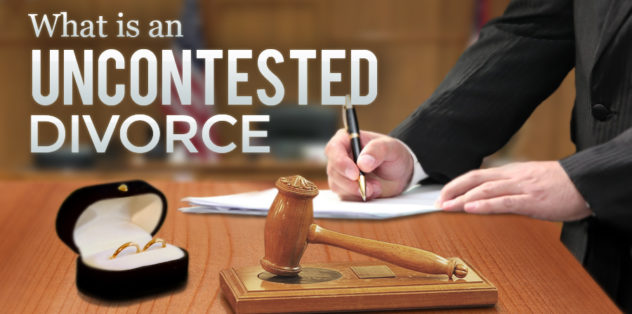WHAT IS UNCONTESTED DIVORCE
Most divorces in the United States qualify as an uncontested divorce. Uncontested divorce is when you and your spouse agree to the terms and conditions of your divorce, without the court intervening in the following categories:
- Child Support, Custody and Visitation
- Division of Assets
- Division of Debts
- Property Distribution
- Spousal Support
This is because the threshing out of the foregoing enumerated issues in court can take so much money (as most family law lawyers charge hourly rates not to mention other incidental expenses), substantial inconvenience (having to appear in court several times) and time (can take many years)–and the emotional strain that is expected in highly emotionally charged family conflict and protracted litigation. In uncontested divorce, it is likely that the couple will no longer appear in court as the uncontested divorce papers can simply be submitted in court. Once these required uncontested divorce papers are filed at certain stages, the court will simply issue the Divorce Decree.
In California, the Divorce Decree becomes final only after six (6) months from the date the respondent was served with Summons. Thus, even if the Divorce Decree was issued on the third or fourth month since Summons was served on the respondent, it will only be effective six (6) months thereafter. Either spouse is NOT allowed to remarry before the effectivity date otherwise subsequent marriages before the effectivity of the Divorce Decree are bigamous. In California, the guilty spouse can also be held criminally liable under Section 281 and 283 of the California Penal Code.
In a true default proceedings, there is often an anticipation that there will be no response from the other party. There are few instances when the Petitioner files the Petition but the other unexpectedly does not submit the Response and let the Petitioner have an exclusive take on the uncontested divorce proceedings. Thus, once all uncontested divorce papers are completed and filed with the court, a Default Judgment is issued.
A true default divorce proceedings happens when the respondents fails to file the Response for whatever reasons and there is no written agreement between the parties. The usual scenario starts with the Petitioner filing the Petition for Dissolution of Marriage before the Superior Court of the place where either party is a resident. Summons are then issued by the court and served to the respondent who is given thirty (30) days to file a Response with the court.
If the respondent fails to respond within the 30-day period, the Petitioner can then request the court to declare said respondent “in default”. A party considered in default shall not be allowed to participate in the default proceedings and whatever the Petitioner prayed for in the Petition shall most likely be granted by the court in the Default Judgment. Before judgment is rendered, there are several other documents (property ownership and financial disclosures) that the Petitioner has to file and once received by the court, a Default Judgment is usually issued as a matter of course. Even if the party is not allowed to give inputs in the default proceedings, said party, as matter of due process, will still receive the Default Judgment and a Notice of Entry of Judgment directly from the court.

In this type of uncontested divorce, the parties arrive at an amicable settlement and reduce their agreement in written form known as the Marriage Settlement Agreement (MSA). The MSA becomes an integral part of the required uncontested divorce papers. Every aspect or issue of the uncontested divorce must be clearly laid down in an MSA. MSA includes, but not limited to, all information about the marriage, the properties, child support, custody and visitation, division of assets and debts, spousal support, attorney’s fees, litigation cost and tax ramifications.
The MSA must be duly notarized and the parties are encouraged to seek legal advice or representation before they affix their respective signatures on the MSA. At this stage, it is important to seek advice from attorneys who have the reputation to exhaust every means to settle a case rather those who have the propensity to display aggressive and obnoxious behavior. Sometimes, MSA is left hanging for many months simply because lawyers quarrel on certain trivial matters rather than the spouses themselves—jeopardizing the chances of finally settling the divorce much earlier than expected. Worse, some MSAs are never signed and couples end up engaging in a bitter litigation thereafter.
MSA is intended to govern the relationship of the parties and will provide evidence to the court of their terms of the relationship. While others submit the MSA after the divorce is filed in court, this agreement is preferably drawn up before the filing of the divorce case. In any case, it is strongly advised that MSA be integrated in the Divorce Decree to be issued by the court so that it becomes part of the Court Order and enforceable by the court. If you do not incorporate the MSA in the Court Decree, any violation of the MSA may have to be settled or decided in a separate court action. Separate court action means additional money, time and stress.
Is an MSA required by the court? No.
If you do not have any property, joint debts, no spousal support issue or children, there is probably no need for you to have an MSA in order for you to secure a no-fault divorce decree in the State of California. Thus, parties usually resort to the True Default Proceedings mentioned above.
Uncontested divorce in California
is best suited for married couples who are budget conscious and practical enough to set aside whatever strong and bitter feelings they have for each other. They are very much willing to set aside their pride and emotional baggage for the sake of achieving an amicable, less costly and expedited divorce proceedings. When amicable settlement is attained no one is perceived a loser but rather both parties end up winners and can then move on with their respective lives.















